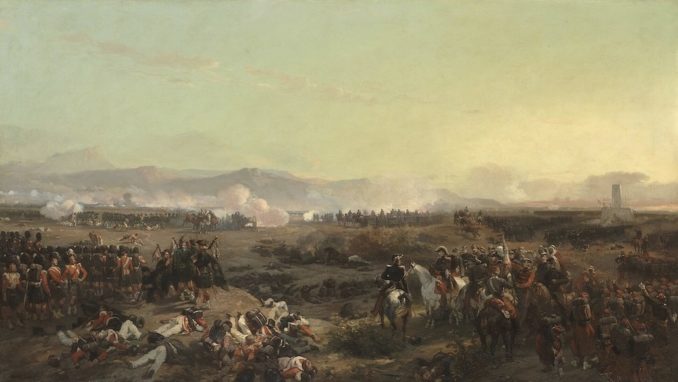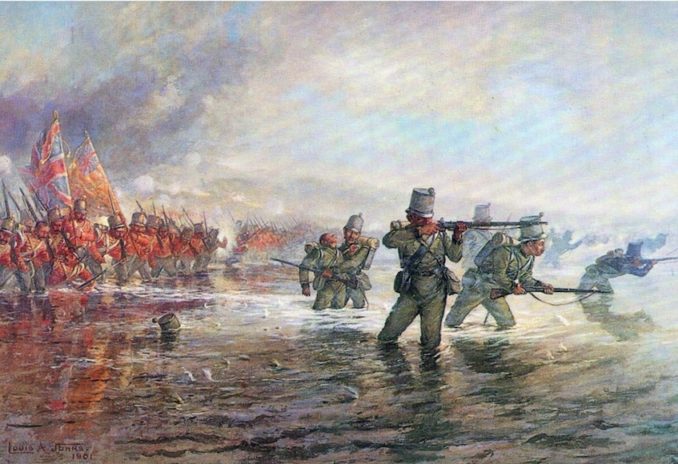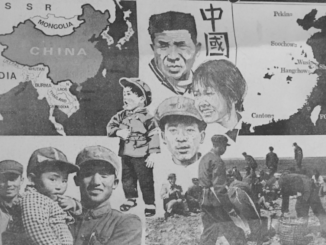In 1954, as the centenary of the end of the Crimean War approached,
my uncle John Alldridge produced a series of articles for the
Manchester Evening News which vividly described that campaign.
In this article, the words are his; the choice of illustrations is mine.
Jerry F
Alma – a grandstand view for the ladies
“The first difficulty is the absence of all information as to the Crimea itself.”
So Prince Albert sensibly observed when informed that, since Russia refused to come out and fight, the Allies proposed to invade the Crimean peninsula, on the south coast of which was situated Sebastopol, Russia’s only naval base on the Black Sea.
Oddly enough – as some more modern soldiers have reason to remember – the absence of maps is never regarded as a serious military obstacle: in April 1915, there was no such reliable map of the Gallipoli peninsula.
The first reaction of the British Cabinet on learning that the Crimea was a peninsula was to order the Fleet to cut it off from the mainland commanding the isthmus with its guns.
An excellent idea in theory; unfortunately, as somebody subsequently discovered, the sea either side of that particular isthmus is never more than two or three feet deep.
And so we have the hilarious picture of the British Commander-in-Chief and his staff steaming round an enemy coast looking for a suitable place to land.
At one point they came so close inshore that Russian officers could be seen watching them through telescopes. “On perceiving which,” we are told, “the English officers took off their hats and bowed.”
The Russian governor of Eupatoria, close to which the Allies finally decided to land, was equally punctilious.
Receiving the formal order to surrender, he first fumigated the document, then read it, and, realising that he must yield to superior numbers, insisted that British and French troops on landing must consider themselves in quarantine.
The disembarkation took place unopposed and without a hitch.
But almost immediately the troops had a foretaste of what two years campaigning on this bleak, arid peninsula, about twice the size of Yorkshire, had in store for them.
The 63rd (Manchester) Regiment, coming in late with the Fourth Division, landed in pouring rain, without their knapsacks.
Each man carried his greatcoat and blanket rolled into a pack containing a pair of boots, a pair of socks, a shirt, a forage cap, and 60 rounds of ball ammunition,
They were wet through before they reached the beach, “but we contrived to make a fire from the planks of one of the boats that had been wrecked in coming ashore, and round this fire we were joined by our chaplain, the Rev R. Halpin.”
Four days later – September 19 – the regiment was on the march.
There was vague news of a battle somewhere to the south. They had been marching for a day and a night when it was discovered that they were heading away from the battle.
Thirteen hours later they finally caught up with the rest of the army. But by that time the battle was over.

Bataille de l’Alma, 20 septembre 1854,
Eugène Lami – Public domain
This was the Battle of the Alma. For the British soldier it remains a worthy battle-honour, even though it was the spirited dash of the French veterans who won it in the early stages and Russians who lost it through sheer incredible stupidity.
In fact the Russian commander, Mentchikoff, was so sure of himself that he invited a party of ladies to watch the opening of the battle. He even built them a grandstand where they could picnic in comfort. And one of the trophies picked by the Guards after the battle was “a lady’s bonnet, very nicely trimmed.”
Indeed this picnic atmosphere seems to have pervaded both sides. Lord Raglan himself rode out to view the battle accompanied by crowd of observers, amateur strategists and general hangers-on nicknamed by the troops “T.G.s” – travelling gentlemen.
The general idea was to dislodge the Russians holding strong positions on the heights on the other side of the River Alma and then push on to Sebastopol, 30 miles away.
But as no combined plan of attack had been decided on, or for that matter discussed, each ally fought its own separate independent action.
Fortunately the Russians had no plan either. They fought their traditional way, “no man receiving any orders and every one doing what he thought best.”
They were urged on by priests carrying crosses, ikons and holy water, and relied more on the bayonet than the bullet.
After Cardigan’s Light Cavalry Brigade had opened with a pretty little skirmish reminiscent of a peace-time review everybody retired for breakfast.
Not until half-past eleven, by which time the French had been waiting with growing impatience for nearly four hours, were the English in line, ready to go forward.
They advanced on a front of two divisions, the 2nd Division – with the 47th (now the Loyal North Lancashires) and 10th (East Lancs) – on the right, the Light Division on the left.
“For a while,” we are told, “the troops were halted and there was a curious and impressive silence – a silence in which the neighing of a single horse was audible to both brigades.”
In that moment of calm before the storm the French commander in chief, St Arnaud, a dying man, rode across their front waving his hat and calling out, “Hurrah for Old England.”
Then the Russian guns opened fire. Great nine-pound cannon balls began to bite into the British line.
At the word of command the red-coated British Infantry fell flat on their faces like so many toy soldiers. And there they stayed for an hour and a half.
For the Guards and the Highlanders, the Loyals and the East Lancs lying there chewing the grass, it must have been a humiliating and frustrating sight to see the impetuous French zouaves and tirailleurs charging on round the hill towards the Russian positions where Mentchikoff’s ladies were already throwing away their parasols in panic.
In fact, the French, with no support materialising from their recumbent allies, were soon in grave danger of being surrounded.
A frantic French A.D.C came racing up to the immovable Raglan shouting dramatically “Nous sommes massacres.”
Slowly that imperturbable line commander rode up and down his line contemptuously drawing enemy’s fire. He looked at his watch coughed politely into his hand and said quietly to Airey, his quartermaster-general: “Get the men on their feet please.”
The British Army rose to its feet on a front of two miles – the Loyals choking in the acrid smoke of the burning village of Bourliuk which the Russians had cunningly set alight.
They went forward under heavy fire, heads down, biting on their shako straps, sweating in the hot sun, urged on by vociferous old ruffians like Colonel Yea at the head of his Royal Fusiliers. “Damn you!” he was roaring at an officer shot in the foot “Why don’t you come on? I’ve got a bullet in my guts but I’m going on.”

Colonel W.L.Yea with his horse, receives a signal from his adjutant,
Robertson James – Public domain
Across their front pouring a concentrated fire down on them stood four battalions of the Borodino Regiment. They went into them methodically with the bayonet “like mice into ripe cheese,” Guards and Highlanders in front, line regiments behind.
“The men never looked back and took no notice of the wounded,” wrote Sterling, of the Highland Brigade. “They ascended in perfect silence and without firing a shot.”
Riding at the head of his Loyals Colonel Haly had his horse shot under him. A plunging shot tore through the Queen’s Colour, killing Sergeant Lomax and Corporal Crane of the Colour party.
Now the attack had been broken up into smaller fiercely fought engagements.
There in the thick of it was Lacy Yea and his Royal Fusiliers, taking on the great Kazan column – 700 against 1,500, “a steady mass of men in long overcoats, with knapsacks of hide on their backs and high spiked helmets on their heads.”
And that great, inert grey-coated mass was beginning to falter. When Gortchakoff, the Russian field commander, ordered it to charge it could not respond.
The Fusiliers had won their private battle.

2nd Rifle Brigade leading the Light Division,
Louis Johns – Public domain
Over on the right a line regiment had got entangled with the Guards. Somebody sounded the “Retire”. A confused mass of British Infantry began to sway down the hill.
“Then the Grenadier Guards went up, quietly opening their ranks to let the retreating through, marching on sternly in the sunshine among the red coats of the dead or wounded who lay so thickly on the grass.”
They were joined by the Coldstreams moving up on the left. Left of them still were the Highlanders. The effect of the bearskins and the tossing plumes coming on, two deep, in orderly ranks seems to have paralysed the Russian commanders.
Desperately Gortchakoff ordered his crack Vladimir column to charge. The Grenadiers met it with a terrific fusillade.
The Russian advance swayed, crumpled, broke, fled in disorder.
The Battle of the Alma was over. “French dash and British phlegm had won the day.”
They could have won the war, too. Pursuit of the enemy at that moment of stunning victory might have carried the Allies into Sebastopol, held by only 12 battalions.
But a halt was called. And, as stretcher parties moved among the dead and wounded, vultures – hitherto unknown in the Crimea – appeared in large numbers.
And when the British left the Alma the vultures travelled with them.
Next Episode: When the Light Brigade missed its chance
Text:
The British Newspaper Archive (www.britishnewspaperarchive.co.uk
The British Library Board
© Reach PLC
Jerry F 2021



